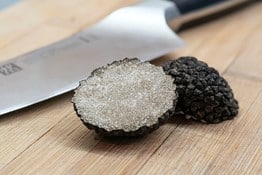Busting 10 Popular Myths About Winter Black Truffle

Let’s face it. At many restaurant tables, it’s as though each plate of food gets truffle treatment. From outlandish ideas such as black truffle ice cream to truffle fries, you can’t deny that the subterranean mushroom has been cropping up on various restaurant menus.
The winter black truffle is highly-prized in the culinary world, subtly growing under a camouflage of dirt. It’s a chef’s diamond in the rough. The value of these mushroom species stems from what they contribute to a wealth of cuisines and the painstaking technique by which they are gathered.
Other names you may be familiar with include the perigord truffle or perigord black truffle.
With that being said, let’s delve into 10 popular myths about the winter black truffle.
Image: Black Truffles
Myth 1: Black Truffles Are Consumed In the Same Way as Their White Counterparts
While most people assume that the white and black winter truffle are eaten the same way, that couldn’t be further from the truth. A black winter truffle serves as an ingredient. On the other hand, white truffles solely come in handy as a condiment. That means Italian black winter truffles are best incorporated during the cooking process (usually at the end) as doing so elevates their flavor in butter, oil, and a bit of heat.
Myth 2: Winter Black Truffle Has a Bolder and More Intense Flavor Than the White Truffle
While it’s lighter in color, most people assume it has a milder flavor than the winter black truffle. However, the truth is that white truffles have a considerably more powerful aroma compared to Italian black winter truffles. For that reason, they are more refined than black truffles and, in turn, pricier (up to five times costlier depending on the quality).
Myth 3: Winter Black Truffle Is Defined More By Its Aroma Rather Than Taste
While the popular myth is that black truffles are categorized more by their smell as opposed to their taste, the opposite is true. For that reason, they are best cooked in low to medium heat, preferably in oil, rather than eaten raw. White truffles are the mushroom species that are almost eaten raw as they add flair to a relatively neutral meal.

Image: A sliced black truffle
Myth 4: Winter Black Truffle Can Be Stored In Oil
While other mushroom species can be stored in oil for preservation, black truffles ferment in oil. Furthermore, since their key gastronomic properties revolve around their aroma, this delicacy loses value if stored incorrectly or not consumed within a particular timeframe.
What’s regarded as ‘taste’ is a blend of various sensations not only shaped by your sense of smell and the texture of the food but also perceived by your taste buds. Therefore, any method of preserved truffles that alters its texture, aroma, or both will undoubtedly kill the flavor of the black truffle in any dish.
Myth 5: Winter Black Truffle Is Hunted With Pigs
Granted, sows have an instinct to dig up the truffle variety as the aroma of the winter black truffle closely resembles the hormones secreted by a wild boar. However, the technique of using a pig as a truffle hunter slowly fizzled out after the Second World War in favor of using truffle hunter dogs.
The reason is that pigs destroy the vegetative part of the black winter truffle when they dig them up, negatively affecting future truffle yields. Furthermore, pigs are harder to control and train even though they have better noses for fresh truffle compared to dogs. As a result, it’s common for them to devour part of the harvest.
Mushroom foragers use specially trained dogs with excellent noses for truffle hunting. The dogs are usually medium-sized dogs with floppy ears and a curly coat. Besides their truffle hunting capabilities, they are regarded as hypoallergenic breeds.
Myth 6: With Proper Storage, Winter Black Truffle Can Be Kept For Months
Unlike popular grocery-store mushrooms that you can refrigerate for months, black truffles should be consumed within 10 days from the date of purchase.
Myth 7: Black Truffles Should Be Peeled To Get Rid Of Debris and Dust
Black truffles should never be peeled. Once you brush them with a small delicate bush or gently wipe them with a damp cloth, you’re good to go. A pointed knife can be used to get rid of dirt in the indentations.
Myth 8: Winter Black Truffle Is a Tuber
Contrary to their botanical name (tuber genus), black truffles aren’t tubers but rather underground, wild fungi (mushrooms) that thrive symbiotically with the roots of their host trees. They can grow on various tree species ranging from linden, oaks, hazels, and poplars to willows. Black truffles weigh between 150g and 400g with a maximum diameter of 12cm.
Myth 9: You Can Artificially Cultivate Winter Black Truffle
Granted, farming some variants of truffles, such as the Tuber Melanosporum, has been fruitfully experimented with. However, the cultivation of black truffles is still in the experimental stage with inconclusive results. That’s because they require a unique combination of climate and soil. Black truffles also need particular host trees for a symbiotic relationship and other plants known as ‘stepmothers.’
Although the ‘co-mothering’ plants don’t join the symbiotic relationship, they play a key role in the development and existence of black truffles. Another aspect that prevents the artificial cultivation of winter black truffles is the time factor.
It can take anywhere between 5 to 10 years, from the inoculation of a seedbed plant to the first mature black truffle. The cultivation conditions coupled with the timeframe make these truffles unrealistic or impractical to cultivate artificially.
Myth 10: Anyone Can Harvest Winter Black Truffle
Prospective truffle hunters must pass an assessment and acquire a permit that proves their ability and knowledge on how to forage for mushrooms. Therefore, only those who wish to harvest truffles on their land are exceptions to this rule. The foraging must be conducted with the help of a specially trained truffle dog.
Furthermore, the process must be conducted with a unique tool and must be limited to the spot that the truffle dog indicates. Besides these provisions, the truffle hunt is open to uncultivated land, including the woods.



